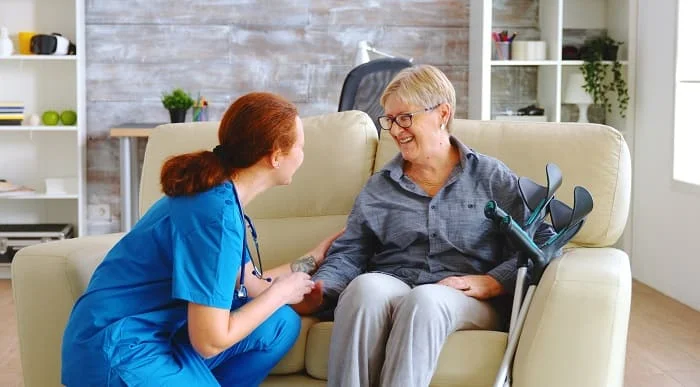Health and Social Care
What is Duty of Candour? Professional and Ethical Guidance at a Glance
We can simply define candour as the aspect of developing qualities which involve being open and honest. Now the question is the duty of candour? It’s to make sure service providers are truthful and ahead of time with their consumers. When the overall activities go wrong, it outlines several responsibilities for providers. This can include informing individuals of the occurrence, providing support, and expressing an apology.
The duty of candour is to be honest and responsible in professional life. For example, A doctor should be honest with their patient if something is wrong with their treatment or any surgery while completing their task.
Read this blog to learn more about the duty of candour. Further, you will also understand how professional and ethical guidance affects candour activities and other important factors.
Table of Content
What is Duty of Candour?
History
By analysing the Care Quality Commission, we found that concerns regarding the investigations into Mid Staffordshire NHS Foundation Trust prompted the introduction of the duty of candour in late 2014. It also goes along with a campaign by Robbie Powell’s parents, who died tragically in the late 1990s. Here, the overall necessity for a statutory obligation of candour for him was developed.
Duty of Candour
As per Public Health England, the duty of candour is the responsibility which requires services to take certain procedures to carry out their obligation of candour whenever a serious adverse occurrence occurs.
Healthcare professionals or doctors, need to realise that if something goes wrong, they must share the overall activities with honesty towards their patients. The duty of candour involves a variety of tasks, so one must complete the following responsibilities:
- If something goes wrong, the doctor must tell the patient or, where appropriate, the patient’s advocate, carer, or family;
- A doctor should apologise to the patient or, where appropriate, to the patient’s advocate, carer, or family;
- A doctor should offer a suitable remedy or support to put things right if possible;
- A doctor should fully explain the short and long term effects of what has happened to the patient or, where appropriate, the patient’s advocate, carer, or family.
This Health & Safety in a Care setting Online Course is an excellent course that will help you identify the common hazards and risks found within care homes. In addition, this course will develop your skillset on certain legislations that apply to care homes, the responsibilities of management and employees in ensuring the health and safety of the vulnerable residents and outlines the procedure of conducting effective risk assessments within premises.
To check out our blog on the principles of the care act.
 Are looking for manual handling training?
Are looking for manual handling training?
Duty of Candour Regulations
By exploring the Duty of Candour at the Public Health England website, we found that the professional duty of candour is to be open and sincere in taking care of the patient for any fault. Duty of candour training involves implementing consistent responses across health and social care.
Any unforeseen, unintended or unexpected incident that occurred in respect of a service user during the provision of a regulated activity that, in the reasonable judgement of a healthcare professional, could result in:
- Severe, moderate, or long-term psychological harm to the service user,
- If the death is directly connected to the incident rather than the natural course of the service user’s sickness or underlying condition, or severe, moderate, or long-term psychological trauma to the service user.
In the case of a registered person who is not a health service body (clinician), a situation qualifies as a “notifiable safety incident” in any unwanted or unforeseen incident (which will follow through with an admission of liability) that appears to have resulted in:
- The death of the service user is connected to the incident rather than the natural course of the service user’s disease or underlying condition.
- A sensory, motor, or cognitive impairment in the service user that has persisted or is likely to last for at least 28 days.
- Changes in the body formation of the service user.
- The service user’s life expectancy will be shortened when the service user suffers from long-run pain or mental harm.
Openness and Transparency
According to the Department of Health and Social Care, “A common culture of serving and protecting patients and of rooting out poor practice will not spread throughout the system without insisting on openness, transparency and candour everywhere in it”.
NHS has also stated that ” All employees of the Trust are required to be honest, open and truthful in all their dealings with patients and the public, and ensure that organisational and personal interests are never allowed to outweigh the duty to be open, honest and truthful.”
All this together makes openness and transparency a significant aspect of the duty of candour.
The government introduced a new statutory duty of candour that will ensure patients are given the truth when things go wrong. This kind of honesty is needed to fulfil the duty of candour.

Health & Safety in a Care Setting Online Course
This Health & Safety in a Care setting Online Course is an excellent course that will help you identify the common hazards and risks found within care homes. In addition, this course will develop your skillset on certain legislations that apply to care homes, the responsibilities of management and employees in ensuring the health and safety of the vulnerable residents and outlines the procedure of conducting effective risk assessments within premises.
The Value of Audits
The invitation, sample collection, reporting, results, intervention etc., are included in the value of audits. There may be insufficient provision at any of these levels, or an existing anomaly may have gone undetected despite an effective program.
An audit can play a vital role in finding out possible issues with any of these procedures. It also aids in the future improvement of the entire process for patients. There would be no way to learn essential lessons from particular cases without the audit.
In many circumstances, audits will not reveal anything is wrong. Regardless of their findings, revealing the results to patients shows that an organisation is open and transparent.
The audit should carefully look for specific segments to identify any misinformation or errors. The review should consider and identify the following aspects:
- Is the process of screening carried out correctly or not?
- Is the program in compliance with national professional standards and specifications?
When to Apply Duty of Candour?
According to the duty of legislation, you must understand the appropriate time for applying the candour duty. The main principles of the duty of candour involve informing the people affected by the incident, offering reasonable support, providing truthful information and a timely apology.
Applying various processes when someone gets a positive diagnosis following a negative screen is necessary.
- Conducting a review of the case.
- Identifying all the factors to understand if something went wrong.
- Disclosing audit outcomes according to patient wishes.
Now, the question is, how does the duty of care relate to the duty of candour? Because both the duty of care and the duty of candour refers to taking reasonable steps to safeguard others from the associated harm.
How to Disclose Audit Results?
The main focus of the audit should be on fulfilling individual needs. For disclosing audit results, the duty of candour should focus on the duty of legislation along with understanding what happened and utilising textual material to enhance discussions and health literacy.
In addition, some people with particular disabilities or mental health problems may lack capacity and fall under the Mental Capacity Act. Introductory talks should include advocates, important workers, and caregivers.
However, to disclose audit results, one should follow several steps, which include:
Providing information to the patient or their family
When a patient or family arrives for the first consultation after receiving a negative screening result:
- That the screening program examines all past screening results regularly, and
- If they want to discuss these findings at any time, they should contact the doctor in charge of their treatment or intervention.
Disclosing the information
Sometimes the clinician in charge of the treatment or intervention doesn’t work for the organisation where the screening took place.
In this case, the organisation must clearly understand how and who should get the patient’s information.
Both parties should document their agreement and disclose the results of any discussions with the patient about the audit’s findings and actions taken.
When to give the information
Clinicians must be adaptable, and any information disclosure must take place at a convenient time for the patient. It is the responsibility of the service provider or the clinicians to ensure that:
- The screening service is conscious of the diagnosis
- The outcome of the subsequent audit is locally documented, once known.
The best time to offer the audit result can be determined during the patient’s treatment. However, the appropriate time for information disclosure is during or after therapy. The patient and the doctor responsible for the treatment or intervention may have developed a bond by that time.
Top Courses of this Category
How to Give the Information
It is essential to provide the patient with the opportunity to have a friend, relative, caregiver, or advocate present throughout the discussion while giving the information.
For disclosing the information, the therapist should focus on the following steps:
Informing the patient or their family
It is recommended that when a patient or family attends the first appointment to receive a positive diagnosis following a negative screening result, they are informed:
- That the screening program examines all past screening results on a regular basis, and
- That if they want to discuss these findings at any time, they should contact the doctor in charge of their treatment or intervention.
This information should be repeated at subsequent appointments and included in any written information supplied to patients.
Clinicians should respect a patient’s right to refuse information at any moment. During or after therapy, the patient can alter their mind.
Disclosing the information
Occurrence affected persons must receive notification from the care providers. Provide reasonable support, provide accurate information, and apologise promptly to them.
When revealing information, the care provider should consider the patient’s motivation for seeking it, assess how much the patient wants to know, review pertinent records, and solicit input from the customer on any concerns.
Conclusion
Everyone working in health and social care should be aware of the duty of candour. It is critical to recognise that being true and honest fosters trust between patients and healthcare providers. I hope this article has helped you realise the importance of the duty of candour.
FAQ
Who does the duty of candour procedure apply to?
The “responsible person” in the relevant legislation is an organisation that provides health, care, or social work service to which the responsibility of candour applies.
Does the duty of candour apply to staff?
Yes. The duty of candour must also apply to employees or staff.
What is a candour code?
The Candour code is a guideline which provides information that every healthcare provider must contact patients openly and honestly when something goes wrong.
What does lack of candour mean?
A lack of candour implies more than just deception. It further includes the element of directness and omission of truth in dishonesty by omission.
What is candour in healthcare?
CANDOR (Communication and Optimal Resolution) is a procedure that healthcare professionals and institutions can use to respond to unforeseen events. These events cause patient harm in a timely manner to moderate harm and take the next necessary steps.
What happens if you breach the duty of candour?
If someone breaches a duty of candour can expect regulatory action, as well as, in the most serious circumstances, criminal punishment.
What is meant by the duty of candour?
It means that when something goes wrong in healthcare, every healthcare practitioner must be upfront and honest with patients.
Who does the duty of candour apply to?
It is applicable to organisations rather than people. Further, it also involves individuals in incident management and resolution.
What is the professional duty of candour?
When something goes wrong with a patient’s treatment or care and causes or has the potential to create harm or distress, every health and care provider must be upfront and honest with them.
Why is the duty of candour important?
The duty of candour is important as it teaches us to be honest and open and to provide transparency between patients and healthcare providers.
What stops people from speaking up?
People sometimes believe that no one will hear them or that speaking up will disgrace them, which leads to their not speaking up.
What to Read Next:
- What are the Types of Observation in Health and Social Care? 6 Important Types
- How to Become a Childminder – A Complete Guide
- 8 Examples of Illegal Moving and Handling Techniques in Health and Social Care
- What is Duty of Care in Health and Social Care
- How to become a Nurse – Step by Step Guide















